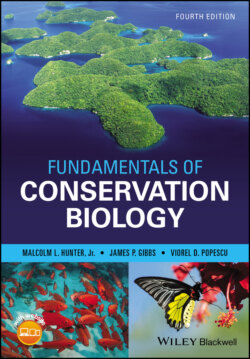Читать книгу Fundamentals of Conservation Biology - Malcolm L. Hunter Jr. - Страница 87
An Important Postscript
ОглавлениеThis focus on the relative species richness of different ecosystems returns us to our earlier discussion about mismeasuring biodiversity by overemphasizing species richness (Chapter 2). Becoming fixated on species richness can lead conservation managers astray. For example, although maintaining the stability of ecosystems is an important argument for avoiding the loss of species, the converse of this argument does not hold: we should not seek to increase the stability of ecosystems by artificially augmenting the number of species, for example by planting new tree species in a forest or adding fish species to a stream network. Similarly, although sustaining species‐rich ecosystems like tropical forests may be a somewhat higher priority than sustaining species‐poor ecosystems, overemphasizing species richness to the exclusion of species‐poor ecosystems would be very short‐sighted. Recall the discussion about salt marshes, home to a narrow range of species but a very important type of ecosystem because of their productivity (see Fig. 4.5). Finally, because each type of ecosystem harbors a unique suite of species, the coarse‐filter approach requires protecting a complete array of ecosystems, even those that may have relatively few species (Fig. 4.10). In particular, many islands support a precious biota of endemic species, but are not very diverse overall; the Galápagos Islands may be the best example of this.
Figure 4.10 The extreme climatic conditions of a high‐latitude or high‐elevation ecosystem (tundra and alpine ecosystems) are the main reason why they support far fewer species than the coral reef depicted in Fig. 4.8. Such ecosystems still merit conservation because of their unique biota and other attributes.
(National Park Service/Public domain)
